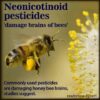Municipalities around the country ramp up their mosquito control programs as warm weather sets in and mosquitoes get busy breeding and biting. A major part of many programs is the use of vehicles or airplanes to spray an “adulticide,” fogging the air with a pesticide concoction to kill adult mosquitoes. Some programs, like that carried out by the Maryland Department of Agriculture, employ Integrated Pest Management and use spraying as a last resort when a threshold mosquito level is reached.

No one likes to be bitten by mosquitoes, and there certainly are health risks such as West Nile virus, but it is incumbent on us to ask what exactly is being sprayed and what risks it poses to our health and the environment. There is particular concern over the effect that mosquito spraying has on honey bee populations.
One chemical routinely used in mosquito spraying is Permanone 30-30, which contains the broad-spectrum insecticide permethrin. According to the Material Safety Data Sheet, Permanone 30-30 is “extremely toxic to fish and aquatic invertebrates and highly toxic to bees.” Permanone 30-30 MSDS
Another chemical used is Fyfanon ULV AG, which contains the broad-spectrum insecticide malathion. According to the Material Safety Data Sheet, Fyfanon is “toxic to birds, fish, aquatic invertebtates, aquatic life stages of amphibians and highly toxic to bees.” Fyfanon MSDS
Based on this we can say with a fair degree of certainty that honey bees (and lots of other creatures) are being killed by spraying for mosquitoes.
-Thanks to a great website, Real Farmacy, for this info. Keep up with them for more information.



